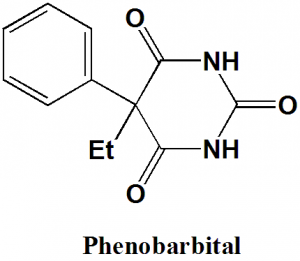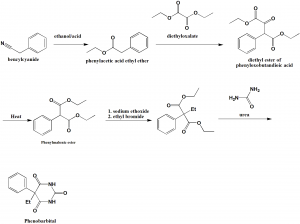PHENOBARBITAL Synthesis, SAR, MCQ,Structure,Chemical Properties and Therapeutic Uses
Phenobarbital
IUPAC nomenclature
5-Ethyl-5-phenyl-1,3-diazinane-2,4,6-trione.
Classification
Phenobarbital is a barbiturate sedative-hypnotic.
Physiochemical Properties
| S. NO. | PHYSICAL AND CHEMICAL PROPERTIES | |
| 1 | Molecular weight | 232.23 g/mol |
| 2 | Physical appearance | White shining crystalline powder |
| 3 | Melting point | 174°C |
| 4 | Octanol/water partition coefficient | 1.47 |
| 5 | Solubility | 1 gm/L in water |
| 6 | Presence of ring | Pyrimidine, benzene |
| 7 | Number of chiral centers | Not present |
Mechanism of Action
- Phenobarbital increases synaptic inhibition by acting on GABAA Due to this, there is effect on the threshold of seizure, and there is reduction in the activity of seizure from the seizure focus.
- Phenobarbital also inhibits the calcium channel. Which results in decrease in excitory transmitter release.
- The sedative and hypnotic effects of the drug is due to the effect of drug on polysynaptic midbrain reticular formation, which controls central nervous system arousal.
Structure Activity Relationship
- Tri-keto form is most stable in aqueous solution.
- 4,6-dialcoholic tautomeric forms are least stable in aqueous solution.
- 5,5-disubstituted barbituric acid is the prime requirement for the barbituares to be sedative hypnotics.
- Esterification of either of the 1,3-diazine nitrogens decreases hypnotic activity.
- Substitution of either of the 1,3-diazine nitrogens with aliphatic carbons retains the anticonvulsive properties.
- Esterification of the 5th-position substituents yields agents with analgesic activity but with weak hypnotic properties.
- Introduction of the polar functional group at the 5th– position yields compounds which are fully devoid of sedative-hypnotic or anticonvulsive activity.
- As the number of carbons at R2 carbon increases, the lipophillicity of the drug increases.
- Modification of the 2nd-position oxygen of the barbiturate backbone with sulfur atom yields thiobarbiturate derivatives with increased lipophillicity, shorter duration of action, faster time of onset compared to oxy-derivative. [1]
Method of synthesis
i. Ethanolysis of benzyl cyanide in presence of acid to give phenylacetic acid ethyl ether.
ii. Methylene hroup of above formed compound undergoes acylation using diethyloxalate to produce diethylester of phenyloxobutandioic acid.
iii. Heating the above formed compound loses caorbon oxide and transforms into phenylmalonic ester.
iv. Above comound under goes alkylation usin ethylbromide in presence of sodium ethoxide to give α-phenyl-α-ethylmalonic ester.
v. Condensation with urea gives Phenobarbital. [2]
Therapeutic Uses
Phenobarbital is used for:
- Treatment of seizures
- For producing sedation during the time of anxiety.
Side Effects
Side effects of Phenobarbital are:
- Insomnia
- Dizziness
- Drowsiness
- Loss of coordination
- Nausea
- Vomiting
- Constipation
- Restlessness
- Headache
- Loss of appetite
- Pale skin
- Shallow breathing
MCQ
Q.1 Sedative-hypnotic effect of phenobarbital is through?
a) Increase the affinity of GABA for GABA receptors
b) Decrease the affinity of GABA for GABA receptors
c) α-inhibition
d) ß-inhibition
Q.2 Therapeutic use of drug Phenobarbital is/are?
a) Treatment of seizures
b) Sedation during time of anxeity
c) Treatment of Diabetes
d) Both a) and b)
Q.3 Which amongst the following are the correct statements with respect to the SAR of drug phenobarbital?
I. Tri-keto form is most stable in aqueous solution.
II. 4,6-dialcoholic tautomeric forms are least stable in aqueous solution.
III. 5,5-disubstituted barbituric acid is the prime requirement for the barbituares to be sedative hypnotics.
a) I, II, III
b) I, II
c) II, III
d) I
Q.4 Number of chiral centers present in the structure of Phenobarbital?
a) 0
b) 1
c) 2
d) 3
Q.5 Correct sequence for the True/False for the physiochemical properties of the drug phenobarbital
I. Molecular weight = 523.25 gm/mol
II. It appears as white crystalline shiny powder
III. Melting point is 174°C
a) TTF
b) FTF
c) TFT
d) FTT
Q.6 Correct statements for the IUPAC nomenclatures of the drugs are?
I. Phenobarbital: 5-Ethyl-5-phenyl-1,3-diazinane-2,4,6-trione
II. Triptorelin: 5-oxo-D-prolyl-L-histidyl-Ltryptophyl-L-seryl-Ltyrosyl-3-(1H-indol-2-yl)-L-alanylleucyl-L-arginyl-L-prolylglycinamide.
III. Phenylephrine: (R)-3-[-1-hydroxy-2-(methylamino)ethyl]phenol
IV. Bicalutamide: (RS)-N-[4-cyano-3-(trifluoromethyl)phenyl]-3-[(4-fluorophenyl)sulfonyl]-2-hydroxy-2-methylpropanamide.
a) I, II, III
b) I, IV
c) I, III
d)I, II, III, IV
Q.7 Match the following drugs with their correct classifications-
| i. Phenobarbital | A. Benzodiazepine |
| ii. Loxapine | B. Nonbenzodiazepine agonist |
| iii. Eszopiclone | C. Benzapene |
| iv.Chlordiazepoxide | D. Barbiturate |
a) i-D, ii-B, iii-C, iv-A
b) i-D, ii-C, iii-B, iv-A
c) i-A, ii-C, iii-B, iv-D
d) i-A, ii-C, iii-B, iv-D
Participate in Online FREE GPAT TEST: CLICK HERE
Participate in Online FREE Pharmacist TEST: CLICK HERE
Participate in Online FREE Drug Inspector TEST: CLICK HERE
ANSWERS
1- a
2-d
3-a
4-a
5-d
6-d
7-b
REFERENCES
[1] Lemke TL, Zito SW, Roche VF, Williams DA. Essentials of Foye’s principles of medicinal chemistry. Wolters Kluwer; 2017, 490-91 [2] Vardanyan R, Hruby V. Synthesis of essential drugs. Elsevier; 2006 Mar 10..

